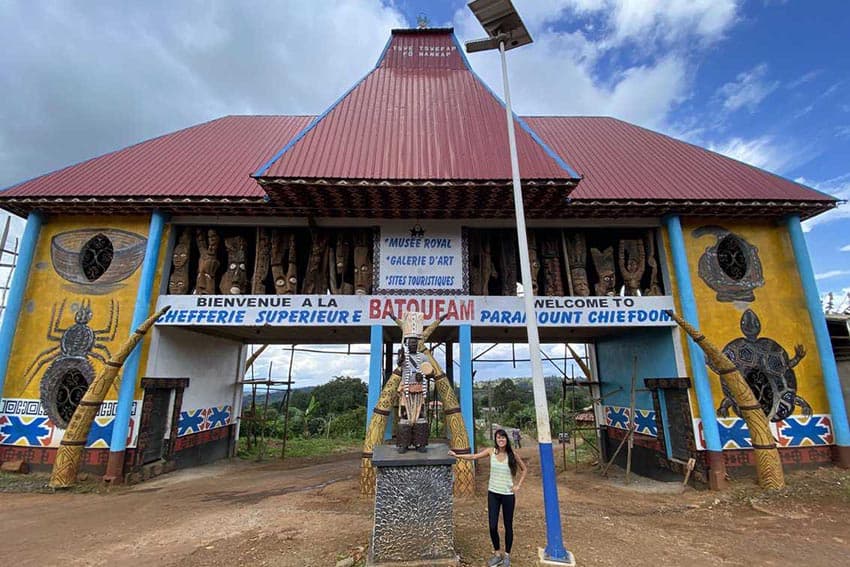
Cameroon and the Fascinating Bamileke People
By Annie Chen
Senior Writer
While the country of Cameroon is divided into 10 regions, arguably the most preserved in their traditional ways and culture is the West.
Out of the three million people in the country and over 240 ethnic groups, 38% of the population is a group called the Bamileke (BAHM-a lee kay) who are originally from the West, Northwest, and Southwest regions. In my final month in Cameroon, an opportunity arose to visit a friend’s village so off we went for the weekend.

In the initial part of the 5-hour drive, we zoomed past motorcyclists widely rumored to be high on glue to ironically empower them to drive on dangerous roads.
Green license plates, signifying diplomat vehicles, mixed in with white plates (government cars), yellow plates (police cars), black (new cars with temporary plates), and orange (normal cars).
Taxis sporting names like “Joe Biden Jr.” and “Miami ” weaved around long-distance bus companies slowly chugging along with their names — United Express, TransCam, Touristique, and Man Travel — plastered loudly on the sides.
Cameroon License Plates
We gradually saw fewer license plates beginning with “LT” (Littoral region, where Douala is) or “CE” (Central region, where Yaoundé is) and more with “OU” (Oueste= French for “West”).
Along the road, hunters showed off their latest catches. A long dead monkey lay next to a young man holding up two fresh porcupines. Another group of hunters held up a thick snake tied up in string, a live baby deer, and a bush rat.
Gratefully, when we stopped for a traditional lunch, we were served kondre, a typical stew for the West with beef and plantains.
Considering the inland nature of the region, it was a welcome contrast to the typical food that they serve in Doula, such as ndole (a bitter spinach stew with crayfish, garlic, shrimp, and stewed nuts), eru (bitter local leaves with crayfish or shrimp and/or beef) and miondo/ baton/bobolo (mashed cassava of varying sizes rolled up in long banana leaves).

History of the Cameroon Region
As we crossed the border, the mountains grew steeper and the climate colder as we climbed in elevation.
The number of police checks on the highway also increased in frequency. However, the reason is culturally and historically tied to the region.
Under French rule as a colony from 1916 to 1960, some Cameroonians resisted their reign more than others and one such group was the Union of the Peoples of Cameroon (UPC party). It was composed primarily of Bamileke people, a proud unyielding group who were powerhouses in business, farming, trade, and essential to the economic development of the country.
Genocide against Bamileke
Following independence in 1960, the French influenced the selection of the new president part of Beti, an ethnic group from the South. After reaching a military agreement with France, the Beti-led government targeted Bamileke villages in the early 1960s, killing between 800,000 to 1 million Bamileke people in over 150 villages.
The government and the Bamileke still have an ongoing resentment towards one another, the Bamileke towards the Beti for the unacknowledged genocide and the Beti towards the Bamileke for their dominance in the economic sector and its crucial role in the country.

Due to the tight monopoly in the market that the Bamileke people hold in the West and their successes and close network, the area has not been as diluted in terms of ethnic groups as much as other regions.
Chefferies for Tourism
This results in a relatively closed-off area that is well-preserved in culture and the emergence of the chefferies as a tourist destination.
A chefferie, or a chiefdom, can be visited and toured with a local guide in the respective communities as an open-air museum and we immediately set out to visit the one in Batoufam.
Exploring a Chefferie
The vast complex was strategically built to be a labyrinth, with wall-to-wall wooden sculptures, colorful artwork, and long, narrow open spaces.
Two small steps lead to and from the square doors, so we had to keep ducking through. The guide explained that they fulfilled two key criteria for their chiefdom; respect for the chief and security.

Anyone entering a room or home would automatically need to duck their head down quite low, thus bowing to the chief automatically.
In addition, during times of war and conflict among the tribes, any intruders or aggressors would need to also lower their heads which left their necks vulnerable to defenders that would stand at the entrance ready to behead them with machetes.
Cultural Symbols
The reliefs around all the doorways and carved columns featured several recurring figures and symbols, each one rich in significance. The spider and its web represent the ties with the ancestors.
Four other figures grouped together resemble the Confucius monkeys that “see no evil, hear no evil, speak no evil.”
Keep Problems to Themselves
The interpretation is slightly different, however. The man with his mouth covered is a reminder for married couples to keep their marital problems to themselves.
The carving of the man with his eyes covered warns of excessive curiosity and prying into their neighbors’ business.
The figure with the ears cupped advises against overhearing gossip or information without having the full context which leads to undesirable consequences.
A fourth figure is hiding his genitals and prompts community members to dress conservatively and not overexpose themselves, physically and otherwise.
Apart from the earthy tones, splashes of bright blue and white are found throughout the chiefdom as well as the overall West. Used to represent the balance between the living (blue) and the deceased ancestors (white), the colors were traditionally extracted from bitter spinach (ndole) and potato leaves.

The Chief and His Wives
Anyone the chief sleeps with immediately becomes a wife, and during the la’akam period, any child born is a potential heir to the throne. A chief receives wives in five different categories.
The first is the wives that he inherits from his father, as they remain protected and in high standing for their entire lives. The second category is the strategically chosen wife, such as women from neighboring or potentially warring tribes in order to prevent future conflict.
The third category is women that the chief is attracted to of his own free will and courts. The guide pointed out a woman who had just walked by our group, commenting that she was an example of this third category; the chief courted her from Côte d’Ivoire where she is originally from.
The next two categories are directly impacted by the community members eager to end the la’akam period. Women who wish to give themselves to the chief are the fourth category, and the fifth is daughters given to the chief by their families.

When I asked curiously about how many the chief could turn away – surely, it would be draining to suddenly have dozens of wives for the rest of his life- the guide laughed and commented that the chief is unable to turn anyone away, since he is loving and fair to all.
The only exception made is if the woman has mental impairments.
The Chief’s Quarters
Behind the la’akam courtyard, the guide led us through the small doors towards another space where the daughters stay on the compound.
The sons of the chief are sent away when they turn six years old so they aren’t tempted to sabotage or become jealous of their would-be rivals for the throne.
Along the way, one massive wall had dozens of carved art pieces in tribute to the varied roles played by females in their society.
Intentionally created out of the roots of the trees, to demonstrate the core position of a woman, some of the figures included a blindfolded man, since the husband trusts his wife blindly.
There was a depiction of childbirth, a couple entwined by their marriage, and a woman simultaneously feeding a man and a child. Women who give birth to twins are called Magne, and are given special standing in society, as are the fathers (called tagne).
In an interesting display of modernity, eight of the daughters’ rooms had been converted into guest rooms that could be rented out by tourists.
The guide proudly spoke of the French and American couples coming the next week, and how much the 15,000 CFA (approximately $25 USD) rent per night contributed to the upkeep of the open-air museum and the tour guide services.

Around another corner, the chief’s quarters immediately overwhelmed us with the sheer number of figures and carvings.
My eyes were drawn immediately to the pile of salt in front of the small door, and the guide mentioned that it keeps the connection strong with the ancestors and chiefs before him.
A massive throne sat out front which the guide encouraged my friend and I to sit on, but he was quick to stop my friend’s husband.
Only women are allowed to touch or sit on it, since they could never inherit or take the throne, but a male too near the throne would be considered a threat.
In the final courtyard, the guide’s voice dropped to a near-whisper. The area was for the chief’s spiritual needs and protection.
Opposite rooms were marked for the women and men of the chiefdom to convene once a month on specific days to hold purification rituals for the chief’s well-being.
Snakes carved into the doors keep the chief safe from water in the river which could be poisoned.
A mask with three holes cut out for the eyes and three protruding horns from the forehead hung on the wall with long locks of hair hanging down, said to be shaved hair from prisoners of war.
The Konga people, a type of mythical medicine people, use masks to hide their identities.
They use spiders to diagnose illnesses and every two years, they gather to show a public display of their power. Most recently, in 2022, they reportedly planted a grain of a banana tree which grew to its full height in five minutes.
- The Interesting Bamileke Region of Cameroon - September 11, 2023
- Mombasa, Kenya: Crocs, Snakes and Empowered Artists - April 9, 2023
- Cameroon’s Douala-Edéa National Park - February 11, 2023





